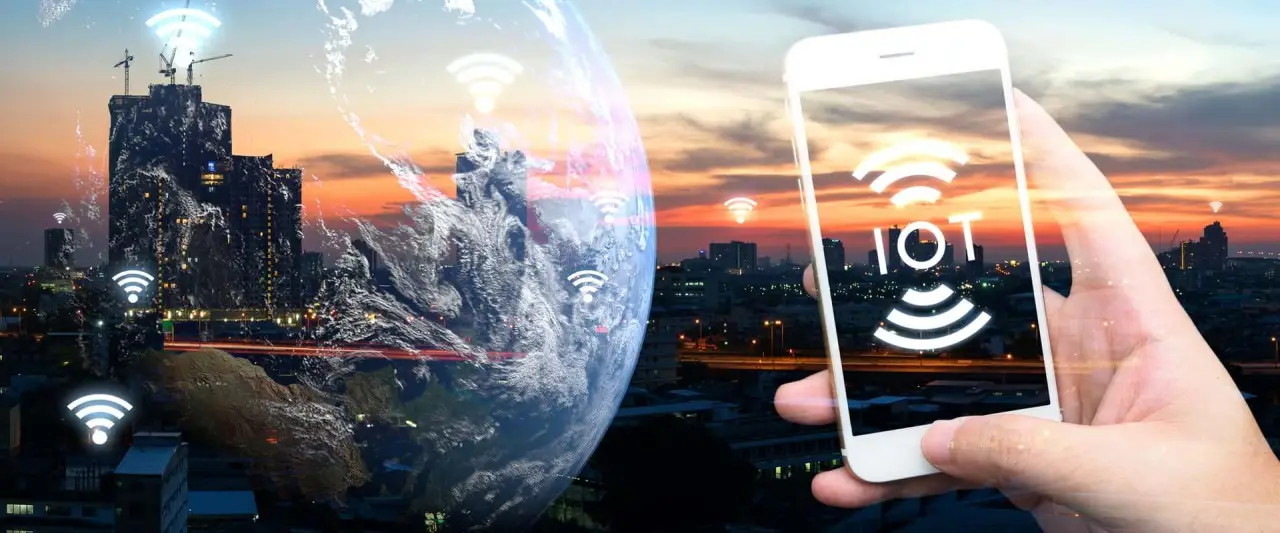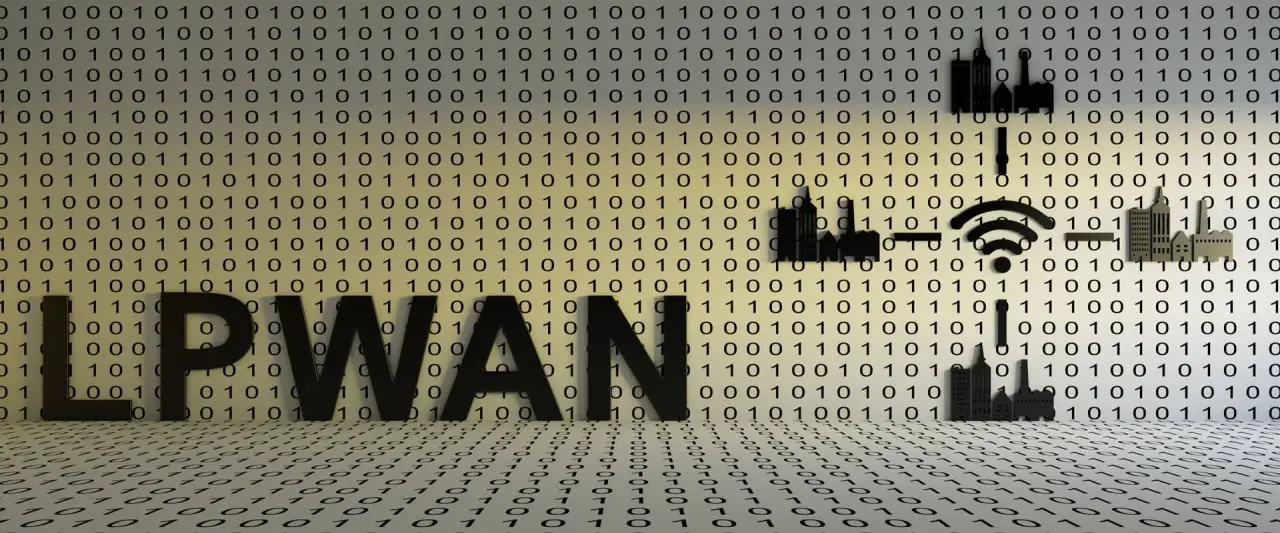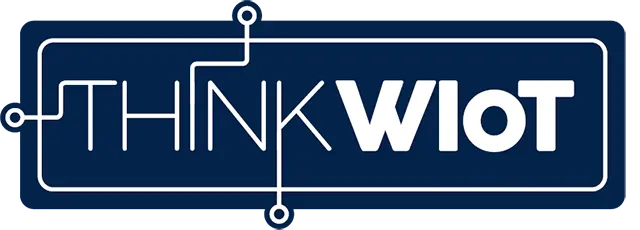Understanding Radio Communication in the IoT Era
Radio communication technologies, spanning diverse frequency bands and modulation methods, form the foundational infrastructure enabling efficient and scalable connectivity in the Internet of Things era.
- Published: July 30, 2025
- By: Anja Van Bocxlaer
- Read: 16 min
- Electromagnetic waves utilize modulation of amplitude, frequency, or phase to transmit digital or analog data.
- Frequency bands are categorized for different applications, with higher frequencies offering more bandwidth but lower range and penetration.
- Radio communication technologies range from short-range NFC and Bluetooth to long-range LPWAN and global satellite systems.
- Advanced methods like QAM, OFDM, and AI-driven spectrum management improve data rates, reduce interference, and enhance network efficiency.
- Health risks from radio waves are minimal under regulated exposure limits, and regulatory measures prevent interference across wireless systems.

Electromagnetic Waves and Carrier Wave
Electromagnetic waves are oscillations of electric and magnetic fields that propagate through space (in a vacuum) at the speed of light, c. A key characteristic is frequency (f), measured in hertz (Hz), indicating how many oscillations occur per second. Wavelength (λ) and frequency are related by the formula c = λ × f: the higher the frequency, the shorter the wavelength.
Wireless transmission uses so-called carrier waves—regular, sinusoidal electromagnetic waves at a specific frequency. These waves do not carry data by themselves; only through modulation is information encoded onto the carrier wave.
Modulation
Modulation means purposefully changing certain properties of the carrier wave—amplitude, frequency, or phase—to encode digital or analog information.
In amplitude modulation (AM), the wave’s height varies.
In frequency modulation (FM), the number of oscillations changes.
In phase modulation (PM), the timing (phase) of the wave shifts.
Modern digital techniques such as QAM or OFDM combine these principles to transmit more bits per second and avoid interference.
Frequency Bands and Spectrum
Electromagnetic radio waves are categorized by frequency ranges because their propagation, range, penetration, and bandwidth vary significantly. The higher the frequency, the shorter the wavelength—and the more data can be transmitted in a short time. However, this typically comes at the cost of reduced range and penetration.
The use of the radio spectrum is coordinated and regulated worldwide. A distinction is made between:
License-free bands (often ISM bands) – for general applications, such as Wi-Fi, Bluetooth, LPWAN
Licensed bands – for cellular networks, broadcasting, and safety-critical services
This international coordination ensures that wireless services function reliably everywhere and do not interfere with each other.
Overview of Frequency Ranges
LF – Low Frequency (30–300 kHz)
Wavelength | ~10 km – 1 km |
|---|---|
Typical Range | Centimeters to several kilometers (near-field) |
Applications | Inductive LF-RFID systems, access cards, animal identification |
MF – Medium Frequency (300 kHz–3 MHz)
Wavelength | ~1 km – 100 m |
|---|---|
Typical Range | Several hundred kilometers (especially at night) |
Applications | AM radio, maritime radio |
HF – High Frequency (3–30 MHz)
Wavelength | ~100 m – 10 m |
|---|---|
Typical Range | Continental to global (via ionospheric reflection) |
Applications | International broadcasting, amateur radio |
Key Frequencies |
|
VHF – Very High Frequency (30–300 MHz)
Wavelength | 10 m – 1 m |
|---|---|
Typical Range | 10–100 km (typically line-of-sight) |
Applications | FM radio, air traffic communication |
Key Frequencies |
|
UHF – Ultra High Frequency (300 MHz–3 GHz)
Wavelength | 1 m – 10 cm |
|---|---|
Typical Range | Hundreds of meters to several kilometers |
Applications | Mobile networks (e.g., 4G/LTE), DVB-T |
Key Frequencies |
|
Sub-GHz Range |
|
SHF – Super High Frequency (3–30 GHz)
Wavelength | 10 cm – 1 cm |
|---|---|
Typical Range | Hundreds of meters to multiple kilometers (often directional) |
Applications | 5G Sub-6 GHz, modern Wi-Fi, point-to-point microwave links |
Key Frequencies |
|
EHF / mmWave (30–300 GHz)
Wavelength | 1 cm – 1 mm |
|---|---|
Typical Range | Tens to several hundred meters (line-of-sight required) |
Applications | 5G mmWave, high-density urban networks, point-to-point links |
Key Frequencies |
|
Wave Propagation, Range, and Penetration
How electromagnetic waves propagate depends greatly on frequency, transmission power, and the surrounding environment.
Lower frequencies can bend around obstacles and penetrate walls better.
Higher frequencies offer greater bandwidth but are more attenuated by buildings, air, and moisture.
Above ~10 GHz, atmospheric attenuation becomes significant, especially due to rain, clouds, and water vapor.
Range depends on:
Transmission power
Antenna gain (focusing energy in a certain direction)
Receiver sensitivity
Polarization (the orientation of the wave’s electric field) also plays a role. Matching polarization between transmitter and receiver improves signal strength and reduces losses. Multiple polarizations can be used to transmit independent signals on the same frequency.
Data Rate, Bandwidth, Channels, and Latency
Bandwidth refers to the range of frequencies a signal occupies. The more bandwidth, the more data can be transmitted. However, spectrum is limited and regulated.
Within frequency bands, channels divide the spectrum into smaller units to allow simultaneous communication.
Example: The 2.4 GHz Wi-Fi band uses multiple channels to enable parallel connections in the same area.
Latency—the delay between sending and receiving—is also critical. Although radio waves travel at the speed of light, latency includes:
Processing delays
Protocol overhead
Network-related delays
Low latency is essential for VoIP and industrial control systems.
Transmission Power and Signal Loss
Transmission power is the amount of energy sent to the antenna per unit time, measured in watts or dBm.
Higher power means greater range but is regulated to prevent interference and health risks.
Signal loss increases with distance and is affected by:
Atmospheric absorption
Rain, walls, and trees
Frequency (higher frequencies suffer more loss)
Communication Direction
Communication can be:
Unidirectional (one-way), e.g., traditional broadcasting
Bidirectional, which is standard today
Half-duplex: Transmit and receive alternately (e.g., walkie-talkies)
Full-duplex: Transmit and receive simultaneously (e.g., mobile calls)
Hardware: Transmitters, Receivers, and Transceivers
A transmitter includes:
An information source (microphone, sensor, computer)
A modulator to apply the signal to a carrier wave
Amplifiers and filters
An antenna for emission
A receiver consists of:
Antenna
Bandpass filter
Low-noise amplifier
Demodulator
Signal processing
Modern devices often use transceivers—integrated transmitter-receiver units—controlled by digital signal processors (DSPs) and microcontrollers.
Comparison with Optical Communication
Wireless communication uses radio and microwave frequencies (kHz to ~300 GHz), which penetrate obstacles better than optical signals.
Radio waves (up to a few hundred MHz): long-range, strong penetration
Microwaves (300 MHz to 300 GHz): used for high-speed data and directional communication
Optical communication (e.g., lasers or infrared):
Works in much higher frequency ranges:
Infrared: ~300 GHz to 400 THz
Visible light: ~400–800 THz
Ultraviolet: >800 THz
Requires line-of-sight
Offers extremely high bandwidth and security
The two technologies complement each other—for example in Free Space Optics (FSO), which uses light beams through the air instead of fiber for point-to-point or satellite communications.
Radio Systems and Technologies
The variety of radio systems is immense. Inductive RFID systems in the LF and HF bands enable access control and payment cards. UHF RFID is used in logistics. Bluetooth operates in the 2.4 GHz band and uses energy-efficient frequency hopping for short-range communication, ideal for headphones and wearables. Wi-Fi uses the 2.4, 5, and 6 GHz bands for high-bandwidth networking within buildings.
LoRaWAN utilizes sub-GHz bands for kilometer-wide connections with low data rates and is ideally suited for IoT applications like agriculture and smart cities. Zigbee and Thread enable mesh networks in buildings. Cellular networks (GSM, UMTS, LTE, 5G) use licensed frequencies to provide high availability and quality of service for voice calls and mobile internet. Satellite communication covers the entire Earth using L-, Ku-, and Ka-bands. Interplanetary communication employs S-, X-, and Ka-bands, increasingly supplemented by optical laser links.
Frequency Bands, Regulation, and Interference
The selection of specific frequencies depends heavily on physical properties and regulatory requirements. Lower frequencies offer longer ranges and better penetration, while higher frequencies allow greater bandwidth. Regulation is necessary to avoid interference, protect safety-critical communication, and ensure fair spectrum usage.
In unlicensed ISM bands, interference can occur when many systems operate simultaneously. Techniques such as channel division, time division multiplexing, frequency hopping, and access control help minimize disruptions. Modern systems often operate in hybrid configurations—such as cellular and satellite (NTN), Wi-Fi and cellular roaming, or self-organizing mesh networks.
Health Aspects
Radio waves are classified as non-ionizing radiation, meaning they cannot dislodge electrons from atoms or directly damage DNA. Potential warming effects are known and are regulated through legal exposure limits. International organizations like the WHO and ICNIRP monitor ongoing research and adjust recommendations accordingly. To date, there is no consistent evidence of harmful health effects when exposure limits are observed.
Classification of Radio Technologies
Radio technologies can be broadly divided into four range classes: short, medium, long, and very long range. Each class has its own advantages and disadvantages. Here is a brief summary of the most important characteristics:
Short Range: Smartphones, Tokens, or Chip Cards
Short-range communication technologies consume little energy, offer fast data transfer, are low-interference, reliable, and often cost-efficient since they require minimal infrastructure. NFC (Near Field Communication) is a key example.
Range: A few centimeters
Typical applications: Access control, payment transactions, or authentication using smartphones, tokens, RFID, or NFC cards.
Medium Range: Building Automation, Asset Management, Inventory, and Container Management
Medium-range radio technologies have a range of up to 100 meters. This group includes the wireless technologies Bluetooth Low Energy (BLE), Wireless Local Area Network (WLAN), Ultra Wide Band (UWB), and Radio-Frequency Identification (RFID). The maximum range is a few hundred meters.
If many wireless systems are to be operated in parallel, radio technologies with a short or medium range are prone to errors and interference.
Ideal application scenarios for medium-range radio technologies include building automation, asset management in hospitals, inventory in retail, container management in logistics, or industrial identification, for example, to name just a few.
In combination with UWB technology, radio technology scores with real-time localization. They send information about the status of an object (in conjunction with sensors), and provide information about the location of an object. These are just a few examples. In reality, hundreds of use cases with short-distance communication technology are conceivable.
Long Range: Communication Technology That Works Miles Away
The third method of radio transmission offers a long range. This radio technology can transmit information over several kilometers. The advantage: It is not restricted by buildings or walls. When it comes to transmitting large data packets over an equally long distance, this technology is ideal. However, it consumes more energy than short-distance technologies. Data transmission can be slower, as longer distances also have to be covered, and interference can occur in heavily frequented areas. Long-range radio technologies include all Low Power Wide Area Networks (LPWAN) technologies, for example.
The application scenarios for long-range radio technologies go beyond spatially limited scenarios. LPWAN technology makes it possible, for example, to monitor the condition and position of construction vehicles over hundreds of kilometers, to record sensor data for an entire city, or to monitor entire industrial parks.
LPWAN networks currently dominate, either operating in license-free frequency bands, such as Long Range Wide Area Network (LoRaWAN), mioty and Sigfox, or based on existing mobile communications infrastructures, such as NB-IoT and LTE-M.
Another interesting representative in this category is Wi-Fi HaLow (IEEE 802.11ah). Wi-Fi HaLow operates in sub-gigahertz bands (around 900 MHz) and is specifically designed to extend the range well beyond that of traditional Wi-Fi systems—up to several hundred meters, or even over a kilometer under ideal conditions. While it offers lower data rates than classic Wi-Fi, it is energy-efficient and supports connectivity for a large number of devices simultaneously. Typical use cases include IoT applications such as smart agriculture, warehouse logistics, or industrial monitoring—scenarios where large areas need to be covered with just a few access points, and long range is more important than maximum speed.
An important future competitor is likely to be the next-generation mobile communications standard (5G), which should be available throughout Germany by 2025. On the one hand, this standard offers functions that ensure low energy consumption at low data rates, and on the other, functions that enable reliable connections with low latency. This is crucial for autonomous vehicles and industrial plants, for example.
Very Long Range: Global and interplanetary communication
The fourth class includes radio systems that operate over hundreds to thousands of kilometers, including into outer space. These technologies are essential for global networks, satellite communication, and interplanetary missions.
Satellites: Provide coverage for entire continents or even the globe.
Geostationary satellites: TV and internet for remote regions
LEO systems (e.g., Starlink): Low latency, global broadband access
Interplanetary communication: Uses X- and Ka-bands for space probes.
Future technologies: Optical laser links with extremely high data rates over millions of kilometers
While this range class offers massive coverage and infrastructure independence, it is technically complex and expensive. Signal delays across planetary distances can reach several minutes. As such, precise planning, high-power transmitters, large antennas, and advanced protocols are required.
These technologies are crucial for global networking, disaster response, aviation, maritime operations, and scientific space exploration—and will play a key role in building the next generation of global communication networks.
Articles on Think WIOT
Radio Modules from Fraunhofer IAF
The Fraunhofer Institute for Applied Solid State Physics IAF in Freiburg is researching energy-efficient radio modules with higher data transmission rates and better bandwidth utilization. These modules, made of the semiconductor gallium nitride (GaN), form the basis for 5G networks and enable 6G. Gallium nitride reduces power loss and loses less energy in the form of heat compared to other semiconductors.
In other words, gallium nitride enables the production of energy-efficient, miniaturized devices with minimal heat dissipation. Gallium nitride is a component of rechargeable batteries, for example. In radio modules, the semiconductor enables high switching frequencies and significantly improves the efficiency of energy conversion compared to silicon-based modules.

Gallium nitride is the key to achieving the efficiency and performance required for sixth generation (6G) mobile communications.
Prof. Dr. Rüdiger Quay - Institute Director, Fraunhofer IAF
UWB Explained by the UWB Alliance
The article highlights various facets of UWB technology. Advantages and disadvantages are discussed and expert opinions are included. When asked about possible interference from UWB, Timothy Harrington from the UWB Alliance clearly answers “no”. He explains that UWB pulses generate similar noise to computers and can therefore coexist within the frequency band without any problems. The pulse method ensures that UWB signals do not interfere with other radio technologies and can withstand their interference, making UWB extremely robust.
Ultra-wideband (UWB) is a radio technology that is particularly suitable for short-range applications and enables precise location determination thanks to its low transmission power. In the past, UWB was often equated with RTLS, an indoor positioning technology. This may have been true in the past, but new areas of application have emerged in recent years. The spread of UWB chips in more and more end devices is a clear indication of this.
UWB is seen as a key technology in the factory of the future, primarily due to the robustness of the signal, and the variety of use cases that can be implemented with this wireless technology. UWB can enable far more than just precise real-time localization and will continue to gain significance, especially in the smart home sector.

At the beginning of the 2000s, UWB was mainly used in sports and for some solutions in industry. Today, UWB is also conquering numerous fields of application in logistics, smart homes, and in healthcare.
Tim Harrington - Chairman, UWB Alliance
An Overview of LPWAN Technologies
Insights into LPWAN from Pepperl+Fuchs
Every day, data networks that connect thousands of sensors via a gateway enable the reliable transmission of machine statuses or environmental data. These networks are implemented using one of the numerous LPWAN technologies. Without these Low Power Wide Area Networks, the vision of the Internet of Things would not yet have become reality.
This technical article was written in collaboration with Wolfgang Weber, formerly part of Pepperl+Fuchs. It sheds light on the various LPWAN technologies and the current status of LPWAN network expansion. The focus is on LoRaWAN, mioty, NB-IoT, LTE-M and Sigfox. The advantages and disadvantages, as well as the perspectives of the various LPWAN technologies are discussed.

Smart metering is a functioning application. With over two million end devices and around 40,000 gateways nationwide, LoRaWAN is used across the board to read water and heat meters. The data can also be retrieved on a quarterly basis via the LoRaWAN networks.
Daniel Möst - New Business Development Manager, Pepperl+Fuchs
Wi-Fi HaLow as a Valuable Addition to the Wireless Portfolio
In this interview, Dr. Daniel Martini from IMST explains why Wi-Fi HaLow is a compelling addition to the IoT landscape. Compared to traditional Wi-Fi, the technology offers significantly greater range—up to one kilometer—while remaining energy-efficient and IP-compatible. HaLow is particularly suitable for applications that require bidirectional communication, such as smart homes, agricultural technology, and industrial automation.
In Europe—and especially in Germany—Martini sees regulatory hurdles. Narrow channel bandwidths and duty-cycle restrictions in the 868 MHz band hinder widespread adoption. While Asia and the U.S. offer more flexible conditions and have seen broader deployment of HaLow, regulation is currently slowing market development in Germany.
Martini emphasizes that Wi-Fi HaLow does not replace existing LPWAN technologies like LoRaWAN, but rather complements them—especially in scenarios that require range, data throughput, and IP compatibility at the same time. IMST offers consulting and development of customized Wi-Fi HaLow solutions but currently sees limited demand in Europe due to high module prices and regulatory constraints.
-%C3%BCber-Wi-Fi-HaLow-responsive.webp)
The Future of Radio Communication
Radio communication is continuously evolving. Higher frequency ranges such as millimeter waves and terahertz bands offer enormous bandwidth for applications like wireless VR or chip-to-chip communication. Optical free-space links and laser connections have the potential to complement or even replace fiber-optic backbones.
Artificial intelligence will enable dynamic and efficient spectrum utilization and network management. Edge AI brings intelligence closer to the source, allowing faster responses within the network. Self-healing mesh networks promise high resilience—even in crisis scenarios. Satellite constellations like Starlink may enable global broadband coverage and establish direct smartphone-to-satellite connections. For interstellar missions, laser links are being tested to transmit data efficiently over vast distances.
Radio communication remains a fascinating and essential field—connecting people, machines, and entire planets. It will continue to grow and transform in the future.
Facts & Figures
In terms of short-range wireless technologies, the global market for NFC technologies and applications is growing. According to a report by the market research platform “Gitnux”, 67 percent of all Point of Sales (POS) terminals in Europe were NFC-enabled by the end of 2020. By 2027, NFC in the consumer electronics segment is expected to hold a global market share of 39 percent. In 2020, 85 percent of all transactions in Australia were contactless. This includes the use of NFC-based payment methods.
The global markets for medium-ranged wireless technologies are also expected to grow. For example, according to a report by the technology intelligence firm “ABI Research”, there were 109 million UWB-enabled devices that were shipped globally in 2019. This number is expected to grow to over 1 billion devices by 2025. According to a market update report by “Bluetooth SIG”, Bluetooth LE will be included in 90 percent of all Bluetooth devices by 2027. The report also predicts 338 thousand Bluetooth RTLS implementations by 2027.
For long-range wireless technologies, according to a report by the data and business intelligence platform “Statista”, the number of LPWAN IoT connections will surpass that of other IoT connectivity technologies by 2030.
